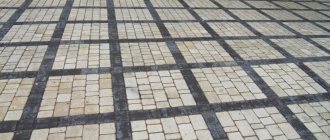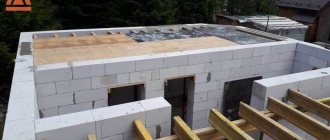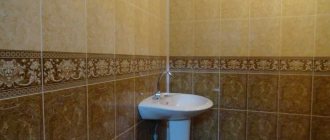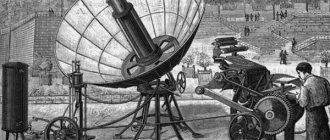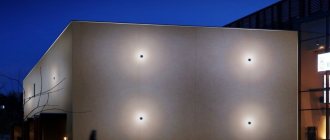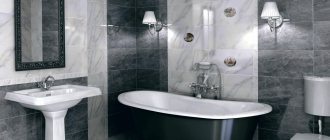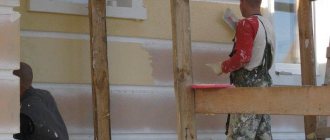Exterior decoration of buildings is one of the key stages of private and multi-storey construction. In the modern building materials market you can find various cladding options, however, facade panels are the most popular.
These products are presented in a diverse range of models, so the buyer can give his home an original appearance and individuality. In addition to architectural features, the material reliably protects wall structures from the negative influence of the environment and provides additional thermal insulation of interior spaces.
Separation of façade panels according to purpose
Panels for exterior facade finishing can be divided into two categories, depending on the intended application. It looks like this:
- Wall
These are large panels intended for cladding wall structures. Despite their impressive dimensions, such elements have a minimum weight: up to 5 kg, so even one person can handle their installation.
- Basement
Such panels are designed to protect the most vulnerable part of the building - the basement. Therefore, the material is impregnated with a special composition that is resistant to a humid environment and resists the formation of pathogenic microflora.
Such models look much thicker and have a more dense structure. When installing basement panels, be sure to lay a layer of heat and waterproofing.
Base panels can only be installed at temperatures above zero degrees; for wall facades, compliance with this condition is not necessary.
Multilayer wall panels
In fact, multilayer wall panel structures appeared as a universal insulation material that does not require additional protective exterior finishing. Such materials occupy first place in popularity for finishing and insulating the external walls of multi-storey buildings and buildings. There are several types of multilayer options used for exterior finishing, the most famous of which are thermal panels and metal “sandwiches”.
In creating the first type of panels, manufacturers tried to cover a thick layer of polyurethane foam thermal insulation with an outer layer of polyvinyl chloride coating with a very expressive surface pattern. Most often, this coating is made in the form of an imitation of ceramic brick or natural stone, but there are options for wood, crushed basalt rubble, and various types of block masonry, typical for the exterior decoration of old buildings and walls.
This type of finishing material is light in weight and can be easily mounted on the wall using pin fastenings on the end surface. Such panels are not afraid of the sun and rain, easily withstand temperature changes and have virtually no effect on the stability of external walls.
The second type of wall panels was developed for the exterior decoration of ordinary buildings, but, unlike the first option, this design can be called a full-fledged sandwich due to its structure. The insulation in it is most often enclosed between two sheets of galvanized metal. There are special mounting grooves at the ends of the sandwich that allow you to connect individual elements into a solid wall.
This version of wall cladding is heavier, has lower thermal insulation characteristics, but is more resistant to the most extreme weather conditions. There is also a simplified version of the sandwich, in which the metal sheet on the inside is replaced with a plastic coating.
The sandwich panel is more expensive and weighs at least 9-10 kg per m2 of finishing, so fastening should be done only on a metal profile, with individual cladding points tied directly to the outer wall using wire and dowels.
Characteristics by type of material
Facade panels are presented on the construction market in a very diverse range of models. In the manufacture of products, various types of raw materials are used, which affects not only the appearance, but also the technical properties of the finished panels.
Based on the type of material used, they are divided into the following groups:
Plastic facade materials (PVC)
In fact, this is a type of siding that has a denser structure. The result is a fairly rigid and high-strength material that is resistant to any external influences. It is worth noting that plastic panels have a long service life, during which they do not lose their original properties and presentable appearance.
The key advantages of plastic facade panels are a wide palette of shades and the absence of special requirements for the care of the material.
Vinyl panels for exterior decoration
This category is considered the most popular in the building materials market. The panels are made from artificial raw materials, where 80% is polyvinyl chloride. To ensure resistance to mechanical stress, modifiers are added to the composition; the desired color is achieved with pigment paints.
- Durability – up to 30 years.
- Operating temperatures -50 - +50 degrees .
- Fireproof - G1 .
- Waterproof.
- The material is easy to cut.
- Lightness – weight 5 kg/sq.m
- Not subject to rotting and corrosion.
- Easy to install and repair.
- Additional protection of the home from heat loss. Thermal conductivity coefficient is 0.16 W/m*K .
- Resistant to ultraviolet irradiation and does not lose color.
The production technology of vinyl panels allows the use of recycled raw materials ( no more than 5% ), which reduces the cost of the finished product.
Polypropylene finishing materials for walls
This is a popular type of plinth panels created on a polyvinyl chloride basis. The material is manufactured in the form of thin horizontal strips, which are convenient for installation and sold in an affordable price segment.
The use of polypropylene panels gives the building an original appearance, however, the material has a significant drawback: high sensitivity to mechanical damage. In addition, a layer of insulation must be placed under such panels.
Ceramic (clay) products for facade finishing
Such panels are called clay panels and belong to the most popular category of finishing materials for facade cladding. The product is based on cement, to which silicate materials or synthetic fibers are added, which ensures high strength of the finished panels and resistance to any external factors and mechanical damage.
In addition, undeniable advantages include environmental safety and a wide choice of textures. An obvious disadvantage is the weight, which is noticeably higher compared to other models.
Fiber cement boards - a natural composite material
Products in this group are a fiber cement base reinforced with metal or polymer fiber. Such models have high sound insulation rates and prevent heat loss. In appearance, the material usually imitates brickwork or natural stone cladding.
- Service life – 20 years .
- Frost resistance – 100 cycles .
- Does not corrode or rot.
- Does not change from ultraviolet radiation (paints contain resins and substances that absorb ultraviolet rays).
- Non-flammable - NG .
- Withstands temperature changes.
- The components of this stove do not contain substances harmful to health and the environment.
- It is possible to restore any façade geometry and eliminate unevenness without prior preparation of the wall surface.
- Reduce heating costs. Thermal conductivity coefficient - 0.12 kW/m* K
- Bending strength – 21.5 MPa .
- Noise absorption coefficient – 29 dB .
- Increases the repair-free service life of building facades.
At the same time, manufacturers offer more than 30 variations of the color palette, which provides freedom of choice. The disadvantages of fiber cement panels include increased weight, which makes installation impossible without first strengthening the wall structures.
Metal facade panels (aluminum with polymer coating)
This category includes panels made of galvanized or stainless steel, however, the most common material is aluminum with a polymer coating. Such panels are often called composite due to their multilayer structure. It looks like this: the outer sides are made of aluminum coated with an anti-corrosion coating. In the middle there is a mineral filler made of non-flammable material.
Specifications
- Durability – service life – 30 years or more.
- Frost resistance – up to 50 cycles .
- Waterproof.
- Do not corrode.
- Fire safety - NG .
- Do not deform due to temperature changes. Operating range from -50 to +50 degrees.
- Easy to install.
- They have different colors and coatings.
- Noise absorption coefficient – up to 20 dB .
- High impact resistance - 50 kg/cm .
- Resistant to acids and alkalis.
- Bending strength* - 118 MPa .
This structure provides the panels with high rigidity and resistance to dynamic loads. The polymer coating protects the base from any external influences.
Wood fiber materials for protective and decorative cladding
In fact, wooden panels for finishing facades (planken) resemble lining, but the key difference is the “flush” fastening of the elements. The result is a natural material that is practically not destroyed under the influence of external factors.
- Service life – 10-15 years.
- Frost resistance - 100 cycles .
- Due to the high density, there is no deformation or cracking of the panels.
- Environmentally friendly material.
- Provides thermal protection and energy saving. Thermal conductivity coefficient: 0.15 W/m*K .
- Provides sound insulation - sound insulation coefficient - 30 dB .
- Bending strength - 45 MPa .
- Ease of installation.
Such cladding can last for several decades without collapsing, while being a completely natural material.
Natural stone panels
In structure, such products are a regular composite panel, where the outer side is finished with a layer of natural stone. The panels are absolutely non-flammable, resistant to any external influences, frost-resistant and bending strength.
Disadvantages include heavy weight and low sound insulation.
Facade porcelain tiles - a reliable solution for ventilated structures
In this case, the outer side of the panel is finished with porcelain stoneware - an artificial material that creates a complete imitation of natural stone. The products have high frost resistance, wear resistance and neutrality to any aggressive environment. The use of such panels significantly expands the horizons of architectural imagination.
- Durability – 50 years .
- Frost resistance – 100 cycles .
- Low water absorption – 0,02%.
- Resistant to ultraviolet radiation.
- Resistant to acids and alkalis (except hydrofluoric acid and its derivatives).
- Fire safety - NG .
- Bending strength – 30 MPa .
- Resistant to temperature changes. Operating temperatures: -50 - +60 degrees.
- Easy replacement of damaged slabs.
The disadvantages of porcelain stoneware facade slabs include high cost.
Glass panels for cladding building facades
In the manufacture of products, fiberglass with the addition of various resins is used. The panels have a lot of undeniable advantages; their texture can imitate any natural surface.
The products attract attention with their presentable appearance and wide color palette, however, they can turn off buyers due to their high cost.
Wall sandwich panels (for curtain facades)
Such products are used for the installation of curtain facades; they represent a multilayer structure, where there is a layer of insulation between the sheets of metal. The material is often used in the private sector due to its low cost, quick installation and relatively good technical characteristics.
- Durability – up to 30 years or more.
- Operating temperatures – 180 – +100 degrees.
- Fire safety - G1 .
- Environmentally friendly.
- Not subject to rotting and corrosion.
- Protects against heat loss - thermal conductivity 0.02 W/(m•K) .
- Bending strength – 24.3 MPa .
- Swelling due to humidity - 1,86 %.
The only drawback can be considered the unpresentable appearance, in which sandwich panels are noticeably inferior to other types of similar products.
In addition to the raw materials, facade panels are divided according to other criteria.
To learn more about this species, go to this article >>>
What types of ventilated facades are there?
One of the most convenient and technologically advanced options for finishing facades has long been the system of ventilated facades. This technology of exterior finishing has been practiced for a long time, but has gained particular popularity only in the last few years.
One of the types of ventilated facade
What is a ventilated facade system?
Ventilated brick facade of a private house
Distinctive characteristics of facades of this type:
What does a ventilated façade consist of?
- Special fasteners for mounting the frame. Installation of such a system requires high quality fasteners. They are necessary for smooth and correct installation and creating the required distance between the wall. Adjustment is carried out using aluminum brackets, which must be passed through a layer of insulation. Thanks to this system, there is no need to level the walls.
- Insulating layer. Thermal insulation is installed between the ventilated facade and the wall; it can be selected from absolutely any materials. It is best to select mineral wool slabs with a double layer.
- Protective membrane from moisture and wind. The insulation layer on top must be covered with a membrane; it will provide excellent protection from wind and cold. In addition, it provides protection from humidity and precipitation, temperature changes and other external influences.
By the way! It will be interesting to know: A protrusion in the form of a pillar on the facade of a building
Ventilated façade design
Installation of this design and its features
Popular structures
Panels for external decoration of wall structures may vary in texture. Models that are complete imitation of natural building materials are very popular. For example:
- Under brick (clinker)
Initially, clinker tiles were developed for sidewalks, but thanks to their high technical characteristics, they found application in the finishing of wall structures. The material accurately copies brickwork, imitating an aged surface or traces of firing. Thanks to this, you can give your house any architectural style: from an ancient castle to a modern cottage. - Under the stone
These models imitate wall decoration with natural stone. The panels look beautiful and presentable; they can be installed on an aluminum profile or glued directly to wall structures with special compounds.
- Under the tree
Such panels are an exact imitation of valuable wood. This texture is considered quite popular, therefore it is found on all types of wall panels.
By choosing the appropriate texture, you can give the building any appearance, while saving on the use of natural building materials.
Advantages and disadvantages of panels for facades
Panels can be made from various raw materials, sometimes creating an exact imitation of natural materials: wood, stone. In addition, there are panels of different sizes and structures on the market. However, each variety has its own strengths and weaknesses.
The undeniable advantages of facade panels include the following factors:
- Absolute protection of the building facade from any natural phenomena, including sudden temperature changes.
- All panels, without exception, are made of artificial material, which is impervious to corrosion and the appearance of fungus, does not fade from prolonged exposure to direct sunlight, and maintains a pleasant indoor microclimate.
- Installation does not require preparation; finishing work can be performed in any weather conditions.
- For fixation, you can use any fasteners: staples, nails, screws.
- During installation, horizontal and vertical placement of panels is allowed.
- Some models create a complete imitation of wall cladding with natural materials.
- Facade panels can be used for the reconstruction of dilapidated buildings and structures, breathing new life into them.
- They belong to the category of non-combustible materials: they do not smoke, withstand high temperatures for a long time without deformation, and do not support combustion.
The obvious disadvantages include the following:
- Installation of some models requires the involvement of professionals, which significantly increases the cost of work.
- Certain types of products are not suitable for regions with harsh climatic conditions.
In addition, facade panels for decorative finishing are quite expensive.
Description of sandwich panels
If you want to choose insulated wall panels for exterior decoration, then you should pay attention to sandwich material, which consists of several layers. The finishing consists of metal, as well as plastic and a vapor barrier layer. This panel does an excellent job of soundproofing and also eliminates temperature changes. Such panels can be fixed using self-tapping screws. If you have to work with a concrete base, you should use dowels. The joints must additionally be treated with sealing mastic. The end seams must be filled with mineral wool or construction foam, and then decorated with planks.
Features of installation of facade panels
One of the key advantages of façade panels is the ability to install them yourself, without the involvement of specialists. There are three main options for finishing work:
- Direct
In this case, the cladding is laid directly on the surface of the walls. It is important to understand that this technology is only suitable for perfectly flat surfaces. Clinker panels are excellent for direct installation, as they serve as additional insulation and decorative finishing. - On the sheathing
This method is suitable for all types of facade panels. In this case, alignment of the walls will also be required, although not as thorough as in the previous version.
- For special mounts
This option is suitable for walls where an additional layer of thermal insulation is required. In this case, the panels are joined together by a system of built-in fasteners. The system is ideal for arranging ventilated facades.
In most cases, installing wall panels resembles assembling a children's puzzle, where the plates are joined together and fixed with fasteners.
Advantages and disadvantages of slabs of various designs
The advantage of using wall panels:
- light weight, due to which there is no need to reinforce the foundation;
- ease of work, not requiring professional skills;
- durability of the finish, for some types the manufacturer provides a guarantee of up to 50 years;
- reliable protection of load-bearing enclosing structures from adverse weather factors;
- many texture options and a wide range of colors.
Composite panels, in addition to the advantages listed above, help solve 3 problems at once:
- insulate walls, thereby reducing energy consumption;
- increase the comfort of your home;
- update the facade, protecting the walls from bad weather.
Thin-layer sandwich panels can be used for cladding both with simultaneous insulation of walls and for purely decorative purposes.
Reliable, time-tested manufacturers
When choosing a building material, the main thing is to find a good manufacturer. Wall panels are in high demand, so there are a lot of fakes on the market. Proven manufacturers with a good reputation include products from the following brands:
- Alta-Profil
This is a domestic manufacturer, one of the first to start producing wall facade panels in Russia. The company has its own production facilities and carefully monitors the quality of its products. As a result, consumers receive high-quality facade panels at affordable prices. - Deke
The homeland of the brand is Germany. For a European manufacturer, Deke façade panels are sold at surprisingly low prices, while traditionally impressing with their high quality and long service life.
- KMEW
This is a Japanese brand, which is one of the absolute leaders of the Russian construction market. The panels of this manufacturer 90% quartz and cement, the surface has a porous structure. As a result, the products have high strength and frost resistance. The front part is covered with a ceramic layer, which makes the panels resistant to any external environment.
- NICHIHA
Another Japanese manufacturer that has won the trust of Russian buyers. Wood fibers, quartz, cement, and mica are used in the manufacture of products. The highlight of this company is the absence of chemical components and additives of inorganic origin.
- FINEBER
This is a Russian trademark. The panels are produced on an automated production line using high-tech equipment. The company produces wall and plinth panels of various colors and textures.
- DOCKE
Russian manufacturer using German technologies. Our products are based on polyvinyl chloride, which allows us to give finished products any texture.
- WANDESTEIN
This is a trademark of a Russian-German enterprise. The manufacturer's assortment includes wall and plinth façade panels and has several collections.
The products of all manufacturers have international quality certificates.
Description of polymer facade products
If you finish with wall panels made of polymers, then you can count on quite impressive durability, so the material can be used for 40 years. The finish will be able to undergo 100 freeze-thaw cycles. The material is moisture resistant and does not swell in water, it does not absorb oil and does not retain odors. The finish can be used at temperatures ranging from -60 to +70 degrees. The material is completely resistant to acids and weak alkalis. The panels are resistant to sun exposure due to the fact that during the production process they are coated with light-resistant dyes. They are lightweight and fireproof, as well as impact resistant. Metal wall panels for exterior decoration are completely non-hazardous in terms of fire, even when exposed to flame. But polymer panels have one drawback, which is the release of toxic waste at the time of melting. You can purchase this finish by paying $11 per square meter.


